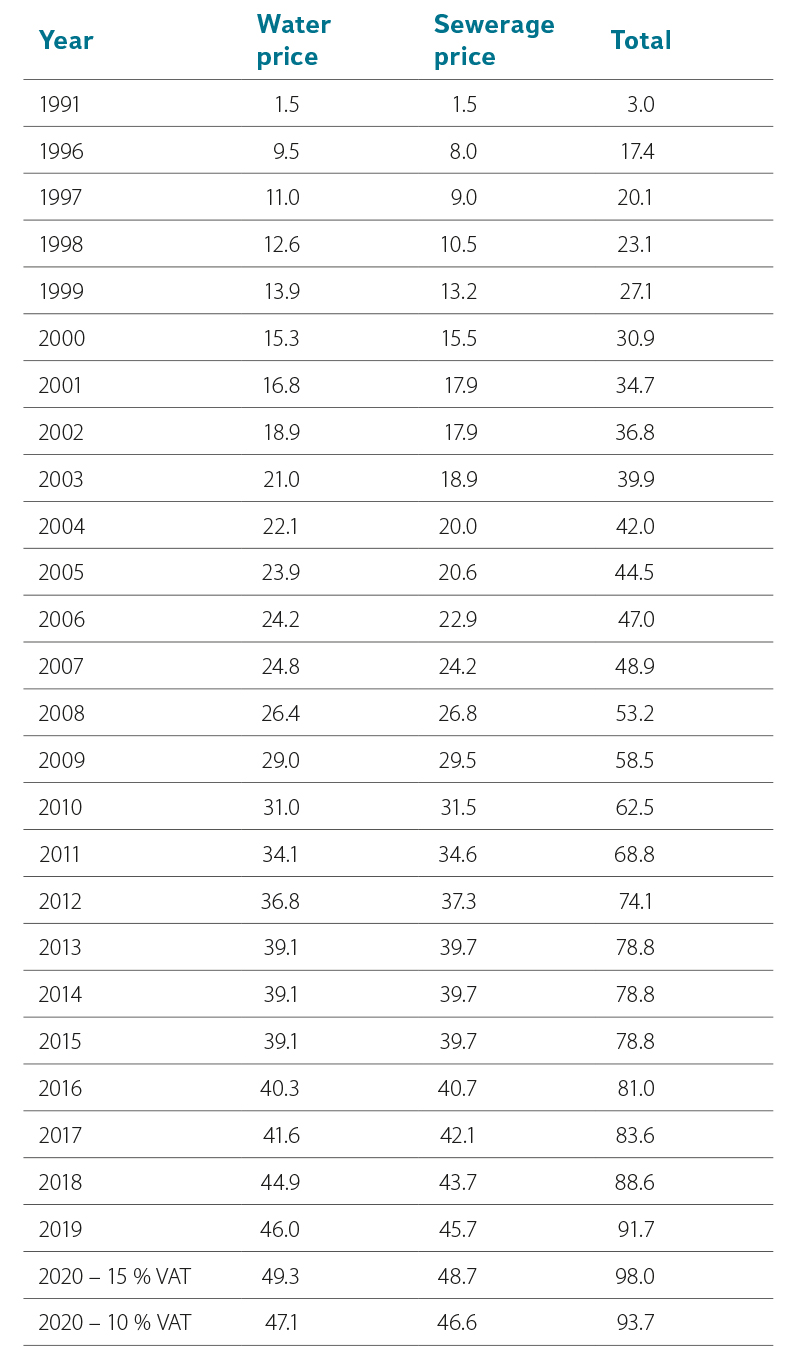SUMMARY
In the second half of the 20th century, the long-term problem of supplying the town of Šumperk with drinking water was finally solved. New sources of drinking water supplemented the missing capacities in the form of surface abstraction from Divoká Desná within the newly built collective water supply system, together with the use of sources in Rapotín and Olšany. A significant contribution to solving the problem was the reconstruction of the water supply network, water reservoir, and intake facilities, which reduced losses. An important factor that has reduced the water consumption of the population is, of course, the significant increase in water and sewerage prices in the last 20 years, which had an impact on Šumperk as well. The operational and organizational conditions of the town’s drinking water supply were negatively affected by society-wide development, which ultimately meant an increase in operating losses in the water supply network due to limited funds for the renewal and upgrading of the water supply network. The political changes in 1989 and the following period were reflected not only in the organizational conditions of the town’s drinking water supply, but also in the final consumption and price of drinking water, both in the Šumperk region and across the whole of the Czech Republic. With the example of Šumperk, it is also possible to illustrate the transformation of the water industry after 1989 and possible difficulties, new starting points, and challenges for its future development.
INTRODUCTION
In the second half of the 20th century, the long-term problem of supplying the town of Šumperk with drinking water was finally solved. New sources of drinking water supplemented the missing capacities in the form of surface abstraction from Divoká Desná within the newly built collective water supply system, together with the use of sources in Rapotín and Olšany. A significant contribution to solving the problem was the reconstruction of the water supply network, water reservoir, and intake facilities, which reduced losses. An important factor that has reduced the water consumption of the population is, of course, the significant increase in water and sewerage prices in the last 20 years, which had an impact on Šumperk as well. The operational and organizational conditions of the town’s drinking water supply were negatively affected by society-wide development, which ultimately meant an increase in operating losses in the water supply network due to limited funds for the renewal and upgrading of the water supply network. The political changes in 1989 and the following period were reflected not only in the organizational conditions of the town’s drinking water supply, but also in the final consumption and price of drinking water, both in the Šumperk region and across the whole of the Czech Republic. With the example of Šumperk, it is also possible to illustrate the transformation of the water industry after 1989 and possible difficulties, new starting points, and challenges for its future development.
The period up to the 1960s
The development stages of the Šumperk water supply system before 1970 are described in detail in an article published in VTEI issue 5/2021. It is possible to take up several important findings that influenced the development in the following period. An important aspect that affected the drinking water supply to municipalities after 1945 was the changes in the political regime. One of the negative consequences of the central planned economy during the Communist era was the centralization of water supply after 1948 and the setting of regulated water and sewerage prices, whose amount for households did not reflect the real costs of producing and distributing drinking water. Interestingly, the regulated price for households remained until 1991. The municipal company Šumperské vodárny (Šumperk Waterworks) lost its own source of electricity after nationalization – a small hydroelectric power plant, which provided electricity for water pumps. As a result, costs increased significantly because the company had to buy electricity. Drinking water to Šumperk was supplied from underground wells, which were gradually built on several springs within the alluvium of the river Desná in the immediate vicinity of the town of Šumperk (Fig. 1).
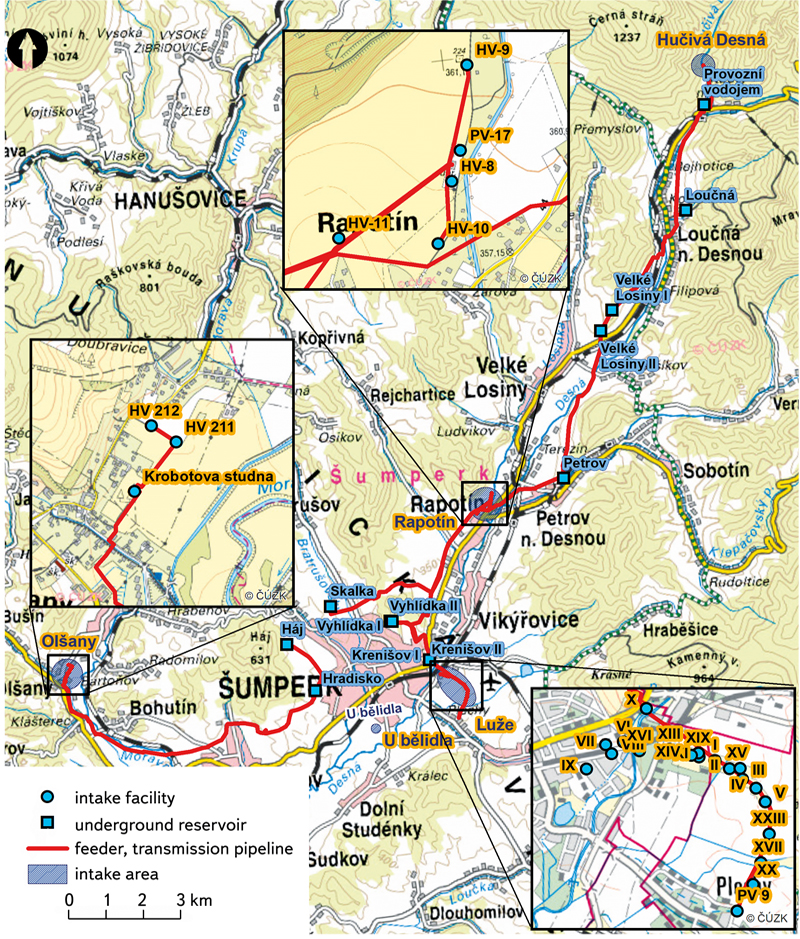
Obr. 1. Jímací objekty zásobující šumperský vodovod v období 1883–2020
Tab. 1. Šumperk town population development with selected water supply network parameters
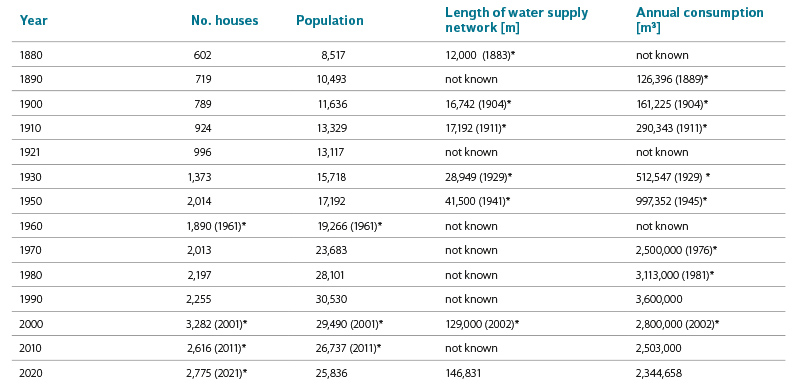
Adjusted according to [4, 13, 14].
*Year of available data.
Given the town’s post-war development, these resources were, of course, not sufficient to cover drinking water consumption satisfactorily. Until the construction of the new source, the public water supply system provided for about 60 % of the population out of the total number of 19,266 in 1961 (Tab. 1).
In 1960, the main source was 13 wells in the Luže spring with a flow rate of about 40 l/s (Fig. 1). In the post-war period, the town tried to initiate a remedy and required several expert opinions, but the bad condition was not resolved until 1971. In 1961, a study was prepared for the investment task ”Collective Water Supply of Šumperk and its Surroundings” by the Hranice project department of the Regional Water Management Development and Investment Centre. The study addressed the supply of the municipalities of the Šumperk region, with a total population of 43,538 in 1962 and with a future supply forecast of over 54,000 inhabitants in 1980 [1]. Two alternatives were developed in the study. The first of them was finally selected by the opposition proceedings of prof.
A. Sukovitý from Brno University of Technology and later built with modifications. This alternative included the construction of surface water intake facilities from Hučivá Desná (140 l/s), Divoká Desná (60 l/s), and a central water treatment plant in Kouty, using the existing groundwater sources in Šumperk (40 l/s).
The second alternative focused on the construction of intake facilities in Hučivá Desná, Divoká Desná, and Merta, which were to form separate operating units with their own water treatment plants. At the end of the study, this alternative was evaluated as less suitable for economic and operational reasons.
Šumperk collective water supply
On the basis of an elaborated and approved study for the investment task for the Šumperk collective water supply system (SVŠ), an introductory project for the SVŠ was prepared in 1966 and, on 4 April 1967, a zoning decision was issued. The construction itself was only started in 1970. The general designer was the Regional Centre for Water Supply and Sewerage Ostrava, project department Hranice, the general contractor of the construction part was Ingstav, Brno state enterprise, and the general contractor of the technological part was Sigma, Hranice state enterprise. Adamovské strojírny, Chepos Chotěboř state enterprise, ZPA Praha, and ZVVZ Milevsko became subcontractors. The proposed system was mostly gravitational (75 %), with 25 % pumping [2]. Due to the height differences of the network, it was necessary to interrupt the hydrostatic pressure by means of two diversion storage water reservoirs for the municipalities of Velké Losiny and parts of the municipalities of Rapotín and Petrov nad Desnou.
In the first phase, due to acute problems with the water supply of Šumperk, an intake facility, a temporary water treatment plant (micro-sieve, chlorination), and a supply pipeline to the existing upper pressure zone reservoir (HTP) of Šumperk were constructed. For the town’s needs, this procedure provided about 30 l/s in 1971 [3]. The temporary solution had to optimize the network, pressure interruption, and venting. Prior to the construction of interruption water reservoirs, the interruption shafts provided the said function (Fig. 2).
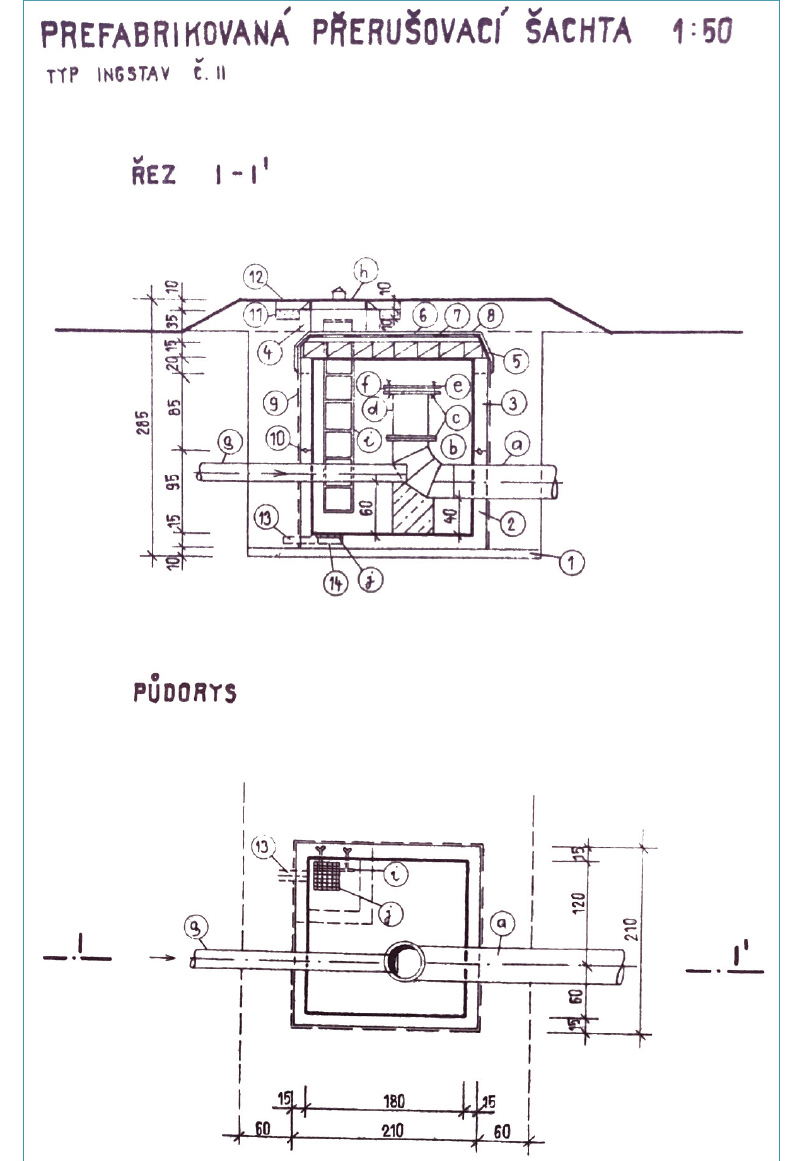
Fig. 2. Intermitent manhole on the supply pipeline of the Šumperk group water supply system in the project documentation [3]
The complete drinking water supply system of all municipalities within the SVŠ was not completed until 1974, with a final price of 42 million Czechoslovak crowns. Interruption water reservoirs with a total volume of 2,200 m3 were built on the Kouty nad Desnou-Šumperk route. Water is supplied to the village of Loučná nad Desnou from a water reservoir with a volume of 150 m3, to Loučná from a water reservoir of 250 m3, Velké Losiny is supplied from a water reservoir of 2 x 650 m3, and Petrov from a water reservoir of 650 m3 (Fig. 3). The project also included the reconstruction of the armature chambers of the existing water reservoirs in Šumperk. The SVŠ system has gravity-fed water mains that transport both 350 mm raw water and 400 mm treated water. In addition to the water treatment technology itself, chemical, physical, and bacteriological laboratories and housing units were built in the two-storey water treatment plant in Kouty nad Desnou (Fig. 4 and 5).

Fig. 3. Overall hydrotechnical situation of the group water supply system Šumperk in the project documentation from 1966 [2]

Fig. 4. Situation plan of the water treatment plant of the Šumperk group water supply system on the project documentation [2]
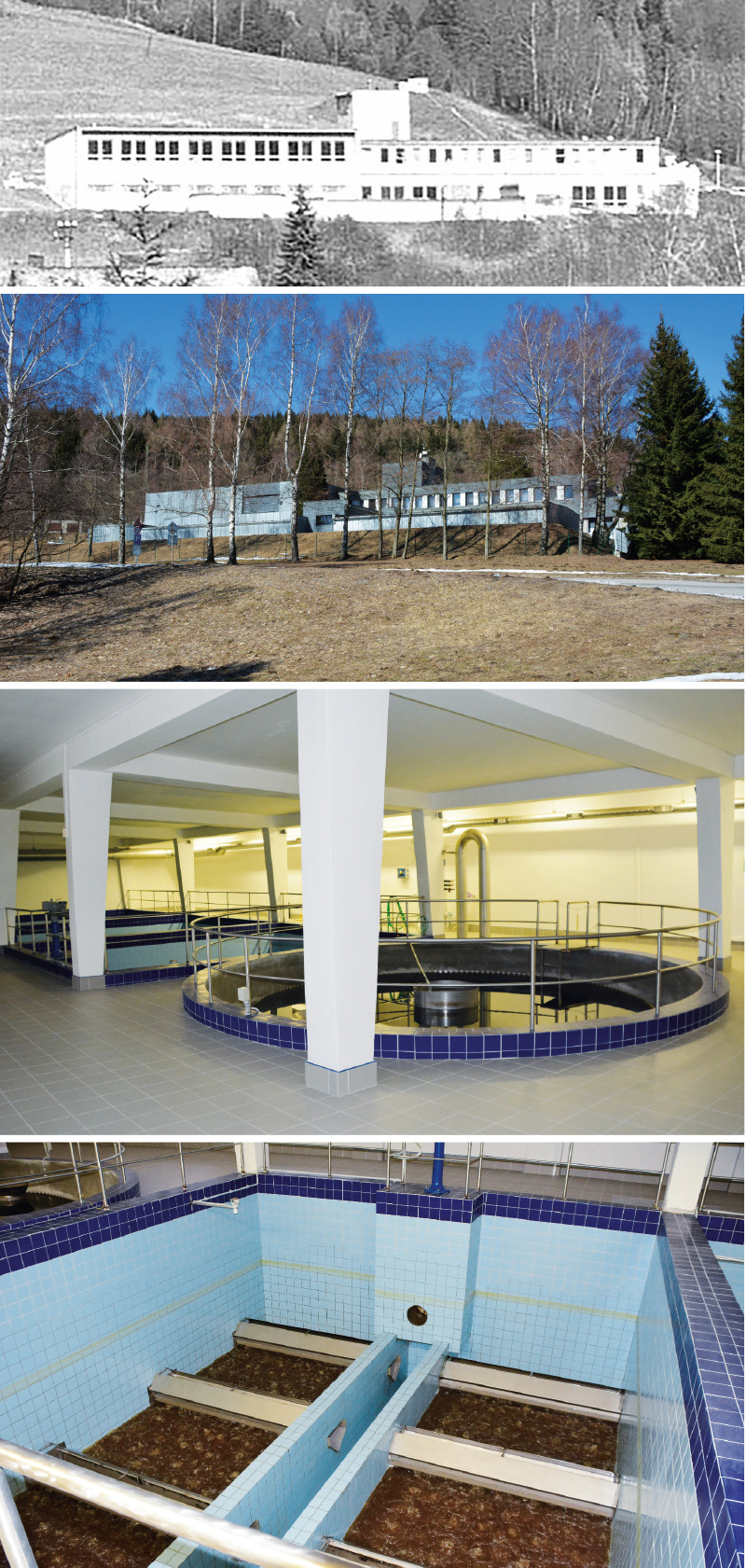
Fig. 5. Water treatment plant at the time of construction (ŠPVS archive), after reconstruction in 2008, the filters hall with reaction tank and filters, filter scrubbing (March 2022, A. Létal)
1971–1989
The key investment for the period is the completion of the Kouty-Šumperk collective water supply system, which was the most important regional water management investment in the second half of the 20th century. Its construction solved the long-term shortage of drinking water for the Desná valley municipalities and the issue of drinking water supply for the 26 municipalities, including Šumperk. The collective water supply system, to which a special subsection is dedicated, provides almost 70 % of the region’s needs. Due to population growth in Šumperk – from 23,683 inhabitants in 1970 to 28,101 in 1980 – the capacity of the existing resources was no longer sufficient and it was necessary to address their expansion. The construction of Dlouhé Stráně pumped storage power plant had a negative impact on plans to increase surface water abstraction and the capacity of resources from the upper Desná river basin in the 1980s. The large concentration of machinery and equipment, as well as extensive construction work in the Divoká Desná river basin, caused contamination with oil substances and the planned source of drinking water could not be used [7]. Therefore, a hydrogeological survey was carried out in the region in 1985–1988, which resulted in the drilling of wells in the future intake areas of Šumperk-Bělidlo, Olšany, and Rapotín (Tab. 4). In the Bělidlo intake area, Bělidlo well was used for supply purposes, originally belonging to the Moravolen company and with a flow rate of about 5 l/s. This source was connected by a transmission pipeline to the lower pressure zone reservoir in Šumperk.
Tab. 2. Newly built water reservoirs

Adjusted according to [3, 6, 8].
The actual connection of the planned intake areas with the use of wells only took place after 1989. Another investment in the water supply network was the construction of a new reservoir in Vyhlídka. The water reservoir solved the increase of the storage space for the upper pressure zone, necessary for the future construction of the Šumperk-Temenická housing estate. The project planned the construction of a reservoir with a volume of 5,000 m3, but the requirement was rejected by the investor – Severomoravské vodovody a kanalizace Ostrava – stating that the capacity of 1,500 m3 is sufficient for local consumption in the future [6]. In 1985, a new 1,500 m3 reservoir was built, at a cost of 3,255,125 Czechoslovak crowns, next to the existing 1,150 m3 upper pressure zone reservoir (Fig. 6).

Fig. 6. Situation of the new 1 500 m3 water reservoir in the Vyhlídka locality on the project documentation [6]
In 1987, the project concept of a water supply solution with a view to 2010 was prepared. Within the framework of this concept, the use of Rapotín and Olšany springs, the construction of a control room, and the headquarters of waterworks in Šumperk on Jílová Street were envisaged. The construction of the Skalka, Hradisko, and Háj water reservoirs was also planned. Back in 1989, a two-chamber underground reservoir Skalka was built with a volume of 1,500 m3, upgrading the water supply from SVŠ to the Horní Temenice area and housing estates in the northern part of Šumperk. The technological solution of the supply pipeline was designed with regard to the possible interconnection of the water reservoir supply from Rapotín spring, which would ensure a possible replacement of the outage from SVŠ.
After 1989 to present
The end of 1989 brought political changes that had an impact on society as a whole, including water management. In 1991, a gradual transformation of water management companies began under the supervision of the Ministry of Agriculture. Šumperk company 09 created a separate unit called Vodovody a kanalizace Šumperk, state enterprise. As part of the development and maintenance of water management infrastructure, the period is characterized by the effort of all companies to repair the damage to the infrastructure caused by the underfunding of the sector in the previous period and to reduce network losses. The sharp increase in prices, which covered the actual costs of production and distribution of drinking water, caused a corresponding reduction in water consumption by households, which eased the limiting capacities of resources, but also reduced the amount of funds paid for water abstracted (Tab. 3). The process therefore led to network optimization, operation automation, measurement and control, and especially to reduced water losses.
Tab. 3. Development of water and sewerage prices in the period 1991–2020 in crowns
Adjusted according to [4, 14].
It was not until 1991 that the water and sewerage prices for households were increased. From 1991, in Šumperk, the water price was set at 1.50 Czechoslovak crowns per 1 m3, and the sewerage price at 1.50 Czechoslovak crowns per 1 m3. As shown in Tab. 4, prices have been constantly rising. Even at the beginning of the 1990s, the planned constructions, which ensured the expansion of water resource capacities, were being finished. As part of the upgrading of water resources, abstraction from the Bělidlo intake area was increased to 13 l/s in 1991 and a new Rapotín intake area was built (Fig. 7) with six wells with a capacity of 30 l/s (Tab. 4). As with other groundwater sources, the water quality is sufficient and it is treated only by chlorination, while the water treatment plant in Rapotín is fully automatic.
Tab. 4. Overview of intake structures built after 1970

Adjusted according to [5, 7, 15].

Fig. 7. Rapotín Water Treatment Plant with intake well (left), engine room (right) (March 2022, A. Létal)
Together with the source at Hučivá Desná (100 l/s) and Luže spring (45 l/s), the capacity of all sources was 188 l/s in 1992. In 1994, the Olšany intake area was connected to the available capacities with two wells with a flow rate of about 80 l/s (Tab. 5), which is intended to upgrade the supply of Šumperk and Zábřeh. The Olšany intake area was supplied by two intake wells HV-211 and HV-212 from 1992. Based on the hydrogeological survey and pumping tests, a maximum flow rate of up to 200 l/s was derived [7]. The capacity of the spring is limited by the diameter of the pipeline to about 80 l/s, with the fact that 70 l/s should be provided for Zábřeh and Šumperk and 7 l/s for the surrounding municipalities [7]. The water is of very high quality and does not require further treatment, except chlorination. In addition to the increase in sources, due to the contamination of groundwater at Luže spring, the abstraction of some wells was limited and the original main water source is gradually losing its importance in the new millennium. Bělidlo spring was transferred to the emergency mode after connection of the Šumperk collective water supply system with the Olšany intake area. In 2002, the water supply for the town of Šumperk amounted to 2.8 million m3, of which production from surface water accounted for approximately 10.7 %. This means that the importance of a key water source in the 1970s–1990s is again replaced by groundwater sources. The length of water supply lines in the town has reached 129 km, of which 42 km are supply pipelines and 87 km are water mains.
An interesting achievement was launching the operation of small hydropower plants in the distribution chambers of Rapotín and Velké Losiny in 1993 (Fig. 8). This approach follows up on the beginning of the 20th century, when a hydroelectric power plant was built for the needs of pump propulsion, which provided the city waterworks with energy to propel their pumps until nationalization in 1946. The facility was designed by Výzkumný ústav čerpadel (Pump Research Institute), a. s., Olomouc. The turbine station is located in the armature chamber of the water reservoirs and consists of a set with a radial spiral turbine with an output of 4 to 55 kW and an asynchronous generator. The small hydropower plants with automatic operation are connected to the supply pipe DN400. Unfortunately, the sets were designed for flow rates from 60 l/s. Due to the decrease in water consumption for Šumperk from the Hučivá Desná intake area, the facility is currently out of operation.
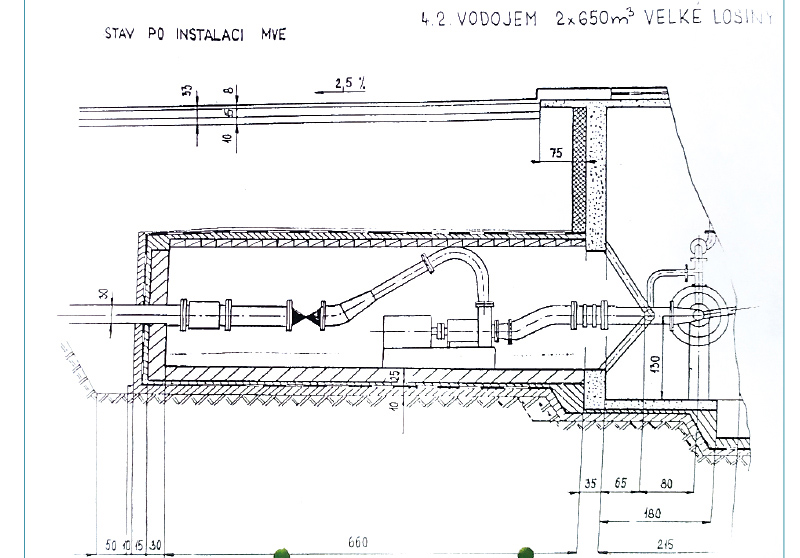
Fig. 8. Small hydropower plant in the Velké Losiny water distribution reservoir on the project documentation
Adjusted according to [5, 7, 15].
In July 1997, catastrophic floods occurred in Moravia, which also affected the SVŠ water supply infrastructure. At Hučivá Desná, the intake facility and part of the supply line were destroyed. A temporary solution managed to prevent the interruption of water supplies and a project for a new intake facility was developed. Due to the need for a stable solution, its construction was started in the same year. Originally, the water was taken by a side intake, which was later supplemented by a bottom steel intake located on a stone step. The outdated technical solution of water intake from the stream was replaced by a bottom intake facility located 20 m above the original intake point (Fig. 9). It is a transverse bottom reinforced concrete sill with an intake trough, covered with screens downstream with gaps of 1 cm, which are detachable (Fig. 10).
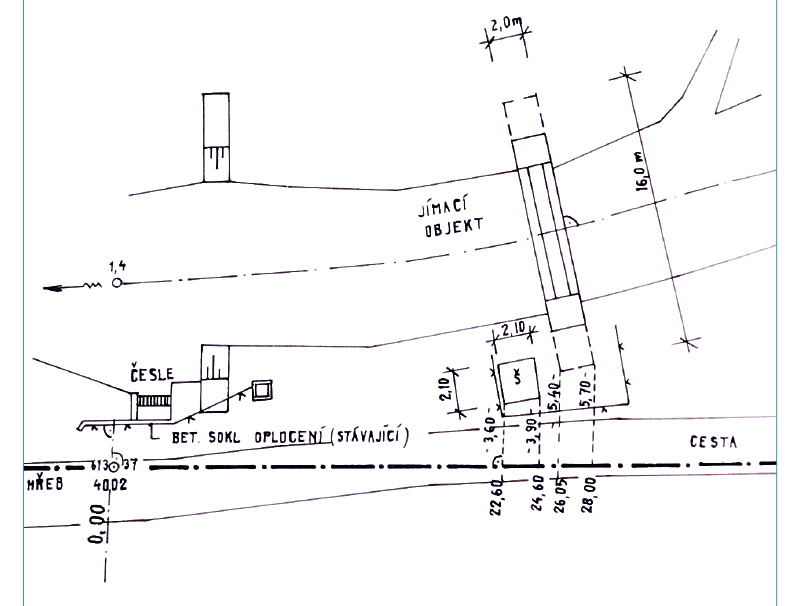
Fig. 9. Intake facilities of the Kouty-Šumperk group water supply system on Hučivá Desná in the project documentation: the original destroyed facility (left), the new facility (right) [10]

Fig. 10. Intake structure on Hučivá Desná river, state after construction in 1997 (ŠPVS archive), current state on the right (March 2022, A. Létal)
Thanks to sufficient investments in new sources and accumulation, conditions were created for the long-term maintenance of a functioning water supply system. Since 2000, investments have been directed to the automation of operations and the reduction of losses. ŠPVS annual reports show a significant reduction in losses from 38 % in 1996 to 16 % in 2020, when they approached the national average of 15.3 % in 2020 [12]. Investment projects that helped reduce losses include the reconstruction of the infrastructure in the historic city centre in 2003, which replaced some of the original elements from 1883. In 2001, the original reservoirs HTP (1935) and DTP (1883, 1935) were renovated, including the reconstruction of the outlet pipe of the 1,000 m3 reservoir from 1935. In 2008, complete reconstruction of the water treatment plant in Kouty was carried out to an amount of approximately 95 million CZK.
The population of Šumperk has been steadily declining since 1992, which means that, as of 1 January 2021, Šumperk returned to the situation around 1970. In 1989, the consumption of drinking water in Šumperk was 171 l/person/day. In 2020, the average consumption of drinking water invoiced to households, industry, and other entities in Šumperk reached 116.5 l/person/day (the national average is 129.2 l/person/day), while in households it was 83.2 l/person/day [12, 14]. In terms of future development, investments in all elements of water management infrastructure can be expected. The main priority is the reconstruction of the feeder from the water treatment plant in Kouty nad Desnou, which was started in 2021 and is divided into several stages. Pipeline repair will be done by non-excavation technology of putting the pre-deformed pipeline (close-fit technology) into the existing steel pipeline DN400 (Fig. 11); a part will be done by non-excavation burstlining technology, which will draw new ductile iron pipeline DN400 into the damaged existing pipeline. Completion of the reconstruction of the 25-kilometre feeder is planned within the next seven years.
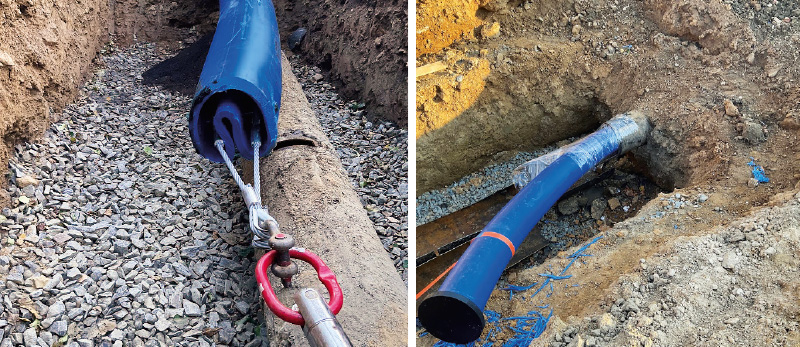
Fig. 11. Example of the repair of the feeder using close-fit technology, implemented by Vodohospodářský rozvoj a výstavba, a. s.
Changes in organization of the town waterworks management after 1945
After 1945, the municipal waterworks was part of the municipal enterprises and was located in the municipal gas works (Žerotínova 448/36). In 1947, the company became an independent part of the town’s enterprises. It was supervised by the council of the town’s national committee. On 1 July 1951, the Regional Water Management Services were established with the regional administration in Šumperk. The investment activity was managed by the water management department of the Olomouc Regional National Committee.
In 1960, Krajská správa zásobování vodou a kanalizací in Olomouc (with operations in Šumperk) was closed and new water management organizations were established within the new administrative division into districts [4]. The development of the company is summarized in Tab. 5. The centralized management of the company ended in 1989. In 1991, an independent organization was established – Vodovody a kanalizace Šumperk, state enterprise. After the privatization of water companies started in the Czech Republic in 1993, two new companies were established in Šumperk in 1994 – Vodohospodářské zařízení Šumperk, a. s. (VHZ), established as a company of water management infrastructure owners (the municipalities and towns of the Šumperk district), and Šumperská provozní vodohospodářská společnost, a. s. (ŠPVS), which is in charge of operation. In 2001, the ŠPVS main shareholder was changed to the French-Belgian consortium SUEZ WATER, s. r. o. The biggest change in the water industry in the region since 1991 came on 27 July 2020. At the General Meeting of Vodohospodářská zařízení Šumperk, a. s., the representatives of 28 municipalities in Šumperk agreed to purchase ŠPVS shares from SUEZ GROUP. The sale of shares took place on 2 November 2020 at a price of 94 million CZK. Funds that were paid abroad to the main shareholder in the form of an annual dividend exceeding 20 million CZK could thus be fairly invested in the infrastructure in the future.
Tab. 5. Changes in the management organisation of the municipal waterworks Šumperk
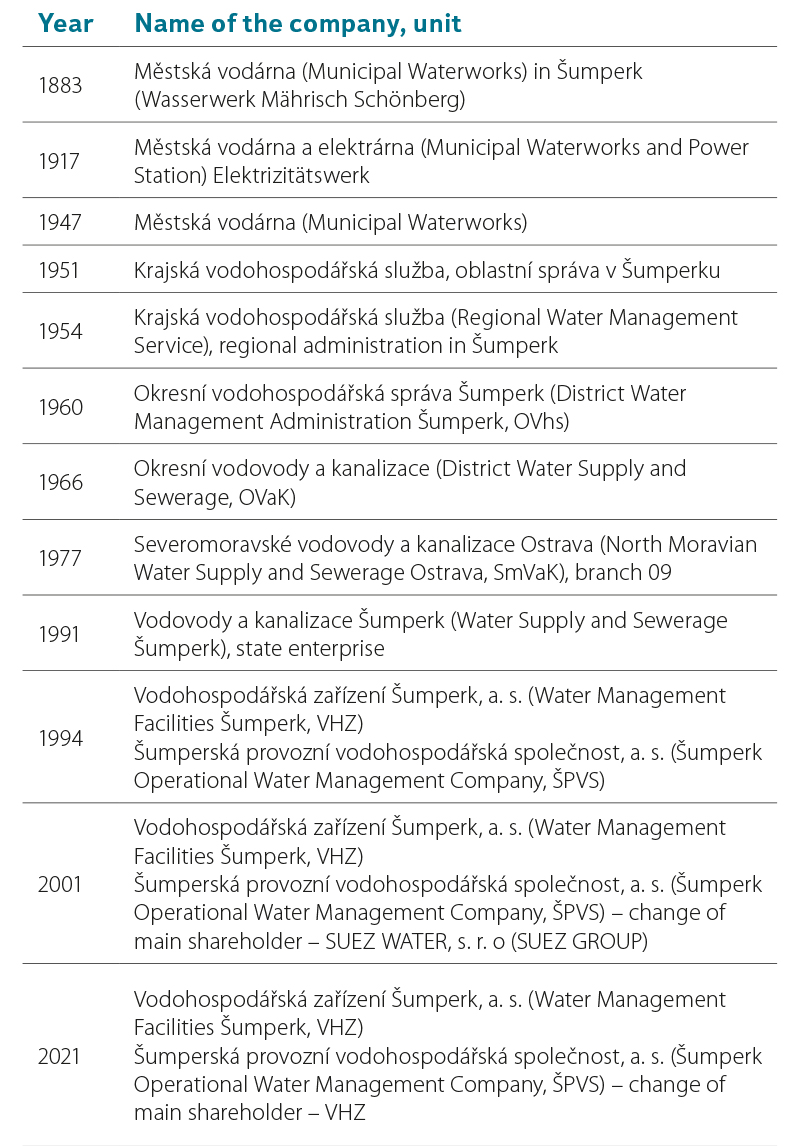
Adjusted according to [4, 14].
CONCLUSION
The issues with drinking water supply for Šumperk and the entire Desná river basin, which the region was struggling with, were solved in the long run by building the Šumperk collective water supply system, which covers 70 % of the region’s needs from. The strategic water management infrastructure built in the second half of the 20th century ensures sufficient quality drinking water without significant restrictions in the future. Due to its dynamic development in the 1970s and 1980s, the town of Šumperk was forced to build additional sources of drinking water, which were provided by wells in the Bělidlo, Rapotín, and Olšany intake areas. The change in Šumperk demographic development after 1989, which meant a permanent decline in population, together with a slowdown in textile production and a sharp rise in water and sewerage prices, brought about a significant reduction in water consumption after almost a hundred years. Of course, this trend was also reflected in the structure of the use of water resources in favour of groundwater abstraction.
The transition from a centrally planned economy to a market economy entailed, in addition to an unpleasant sharp rise in prices, an increase in the amount of funds that can be effectively invested in automation and traffic regulation, as well as in the renewal and reconstruction of existing buildings and network.
The acquisition of the ownership majority from the foreign owner of the VHZ operating company in 2021 marked the beginning of a new stage in the region’s water management infrastructure, ensuring fair investment in the renewal and maintenance of valuable infrastructure left to us by our predecessors.

Fig. 12. View of the building for the administration of the VHZ and ŠPVZ with a control room and facilities for service equipment (March 2022, A. Létal)
Acknowledgements
The paper was created within the research project NAKI II „Historical water management objects, their value, function and significance for the present“(DG18P02OVV019). The project was financed by “NAKI II – support of applied research and experimental developments of national and cultural identity 2016–2022”of the Ministry of Culture of the Czech Republic. Special thanks also go to the employees of Vodohospodářská zařízení Šumperk, a. s., and Šumperská provozová vodohospodářská společnost, a. s., for providing valuable information and materials related to the history of the Šumperk water industry.
